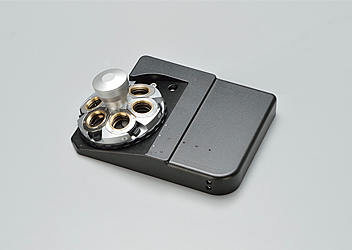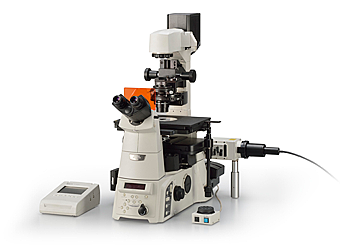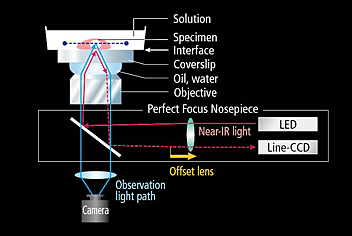Perfect Focus System for live cell time-lapse imagingNikon introduces the new Perfect Focus System (PFS) for inverted research microscopes
Oct 15, 2012
Nikon Corporation (Makoto Kimura, President; Chiyoda-Ku, Tokyo,) is pleased to announce the introduction of two models of new Perfect Focus System (PFS) at the 2012 Neuroscience conference (October 13-17, New Orleans). The new PFS will extend the imaging capabilities of Nikon’s inverted research microscope, The Eclipse Ti, and bring new imaging capabilities to a larger field of research.
Product information
Product name:
- TI-ND6-PFS-S Perfect Focus Unit with Motorized Nosepiece
- TI-ND6-PFS-MP Perfect Focus Unit with Motorized Nosepiece for MP (multiphoton)
Available from December 2012
Background of Development
Inverted research microscope and its peripheral equipment have contributed to the development of life science research with various technical innovations.
Now they are the standard workhorse in many advanced applications such as super resolution imaging which allows for determination of biological structures at the nano-scale level, multiphoton microscopy that allows for the analysis of activities found deep in the brain, time-lapse imaging of some of the most sensitive cells such as iPS cells to study the mechanism of their differentiation.
While significant improvements have been made in improving the spatial and temporal resolution of imaging systems, the ability to correct for focus drifts, which reduce reliability of acquired data, is still one of the most important considerations especially in long-term time-lapse imaging. The Nikon PFS is designed to combat this problem and keeps the focus precisely by making real time corrections.
First released in 2005, the Nikon PFS has quickly become the gold-standard device used in live cell imaging. It was selected as one of the top ten innovations by The Scientist Magazine in 2008.
The new Nikon PFS extends the focus-maintaining capabilities to a wider range of applications and offers upgraded microscope imaging.
Main Features
- Focusing in wider range.
The new Nikon PFS can correct for focus drifts and maintain focus at larger distances from the interface, in time-lapse observation and multipoint observations. This makes it possible to focus on a deeper point of cell, which is important for studying the development of organisms such as the zebrafish, known as the model system for vertebrate development.
- Increased flexibility in imaging wavelengths for multiphoton microscopy.
The MP (multiphoton) model of the new PFS now offers compatibility with a larger range of imaging wavelengths, increasing the flexibility of fluorophores and lasers that can be used for multiphoton imaging.
- Compatibility with plastic dishes.
In addition to glass bottom dishes, the new PFS now allows researchers to image through plastic dishes. This new ability can cut down on costs and simplify the experimental workflow for the researcher when imaging through glass is not required.
- Improvement of usability
With its slimmer, more streamlined design, the new PFS allows for easier access to the objectives and operation of their correction collars. In addition, the new PFS is now completely controlled through the computer or external controller, eliminating the need to open and close environmental chambers that can lead to disturbances in the imaging temperature.

New PFS

Eclipse Ti + New PFS
Structure of PFS
The LED infrared light which irradiated through objective lens detects the interface between the coverslip and the solution.
It can keep on focus based on the interface by moving the position of objective lens even the observation point changes for long time lapse.

- This information is current as of the date of publication. It is subject to change without notice.
